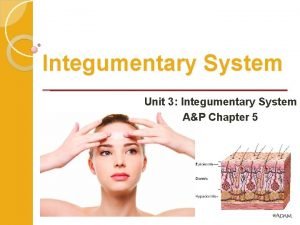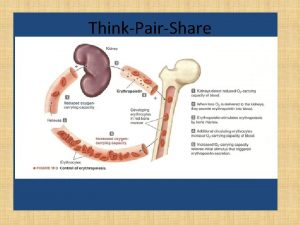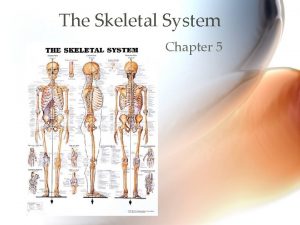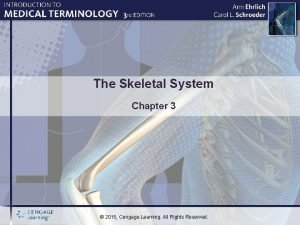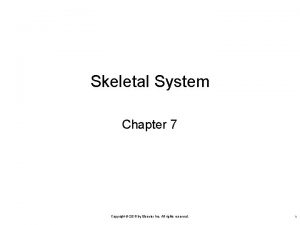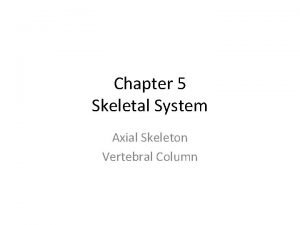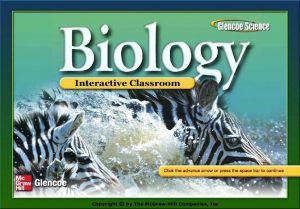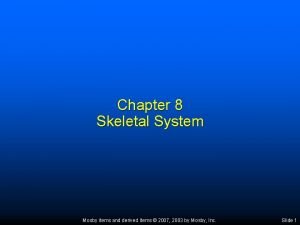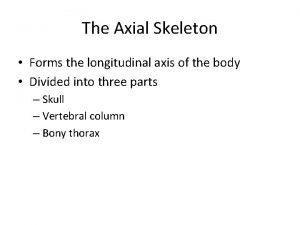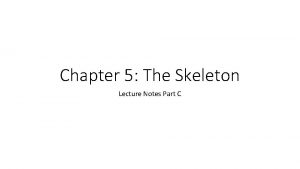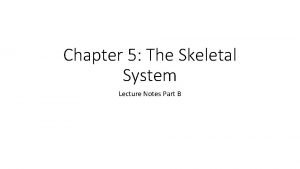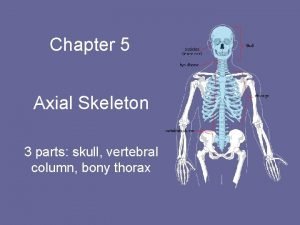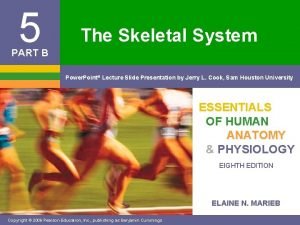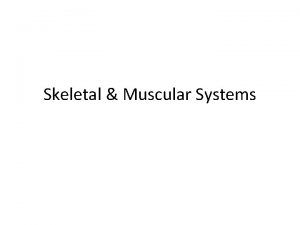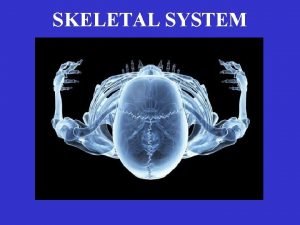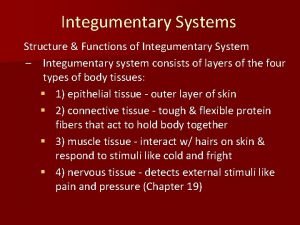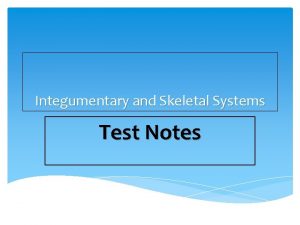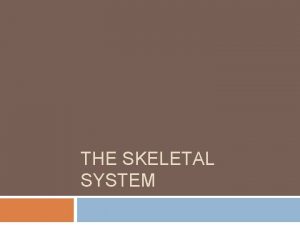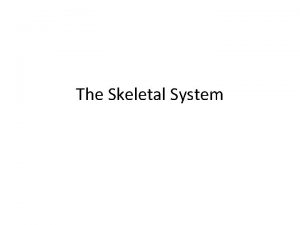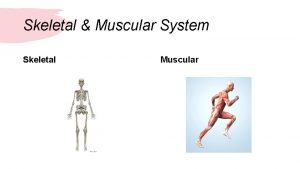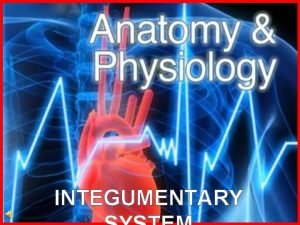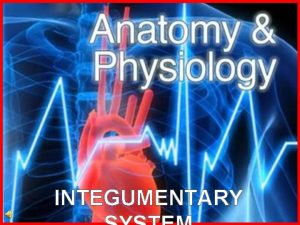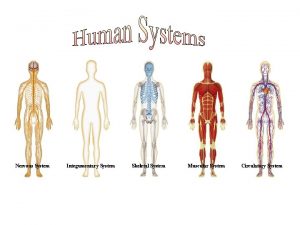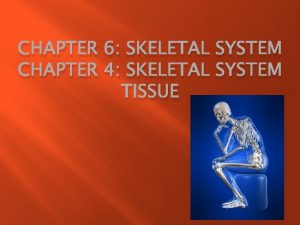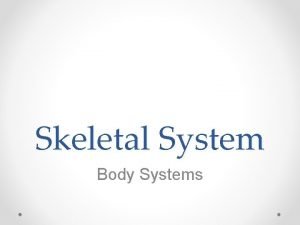Chapter 17 Integumentary Skeletal Systems The Integumentary System





















- Slides: 21

Chapter 17 Integumentary & Skeletal Systems

The Integumentary System n Includes: n n n Functions of the Skin: n n n Epithelial cells make up skin & linings of digestive & respiratory Systems Skin, hair and nails Protect from UV rays Regulate body temp Waste removal Barrier from infection Sensory receptor Two Main Layers & lower layer n n n Epidermis Dermis Hypodermis n AKA adipose tissue & subcutaneous layer Erector muscle Dead skin cells Arrector muscle

The Integumentary System n The Epidermis n n n Two Main Layers Top layer is made of dead cells Rapid cell division – entire skin is replaced every 4 weeks Bottom layer is the basal layer Skin Color from Melanin n Produced in melanocytes located in the basal layer of the epidermis is m r e id Ep Dermis

Melanocytes n n n Melanocytes have many “fingers” that permeate through the dermis. Packets of Melanin migrate thru these fingers and absorb the harmful UV rays from the sun. The more melanin – the darker the skin

The Skin – The Dermis Layer n The Dermis n n n Composed mainly of Epithelial Cells Specialized Epithelial Cells form hair & nails 2 types of glands n sebaceous (oil) – secretes n n n oil to protect skin & moisturize sweat glands (perspiration)– help control body temp removes salts & wastes. Hair Follicles Arrector muscle Capillaries Nerve endings sense – heat, cold, pressure, pain Wrinkles occur here.

The Skin - Hypodermis n n Also known as (AKA): n Subcutaneous Layer n Adipose Layer Fatty tissue serves to insulate, protect and add form

The Skeletal System

Skeletal System Main Function n Support the body n Anchor point for muscle attachment n Protect vital organs 206 bones in the body ½ are in the hands and feet 2 main parts n Axial Skeleton n Appendicular n Skeleton n n 6 smallest in the middle ear : Malleus, Incus, Stapes (hammer anvil & stirrup) n

The Axial Skeleton n Bones of the head & trunk n Skull, Spine & Rib Cage n Vertebral column – 33 -34 bones in 5 regions n Separated by cushioning cartilaginous disks n Cervical Region n 7 vertebrae 1 st vertebrae called the Atlas 2 nd Vertebrae called the Axis

The Axial Skeleton n Bones of the head & trunk n Thoracic Region n n n 12 vertebrae w rib pairs attached 1 st 7 are true ribs – connected to the sternum Next 3 have false ribs – attached to the last true rib w/ cartilage Last 2 vertebrae have floating ribs attached Sternum (Breast Bone) Xiphoid process

The Axial Skeleton n Bones of the head & trunk n n n Lumbar Region – (lower back) w/ 5 ribs Sacrum – 4 -5 fused to help make up the pelvis Coccyx Region – the “tail bone” – made up of 4 fused vertebrae

The Axial Skeleton n The Cranium (Skull) – about 22 bones Know these bones: Frontal Bone, Parietal, Occipital, Temporal, Nasal, Maxilla, Mandible, Zygomatic,

The Appendicular Skeleton n The arms, legs, hands, feet, pectoral and pelvic girdles

The Appendicular Skeleton n The pectoral and pelvic girdles Sacrum Know these bones: Pectoral Girdal: Scapula, Clavicle, head of the Humerus, Pelvic Girdal: Illium, Ischium, pubis, Sacrum, head of Femur

The Appendicular Skeleton n The arms and hands Know these bones: Humerus, Ulna, Radius, Carpals, Metacarpals and phalanges. Know how to name the fingers so you can identify the individual phalanges of each hand.

The Appendicular Skeleton n The Legs and Feet Know these bones: Femur, Tibia, Fibula, Patella, Tarsals, Metatarsals, Phalanges, Talus, Calcaneus

The Structure of Bone n The Legs and Feet Know these structures: Periosteum, shaft, compact bone, spongy bone, Osteocyte, Haversian Canals, Lamella, red marrow, yellow marrow Periosteum – tough covering which supplies blood vessels, nutrients and oxygen to the bone Compact Bone – dense strong hard bone, makes up the shaft of long bones Spongy Bone – porous bone filled w/ Marrow red marrow – contains & makes red and white blood cells Yellow marrow – contains fat and nerve cells

The Structure of Bone n The Legs and Feet Know these structures: Periosteum, shaft, compact bone, spongy bone, Osteocyte, Haversian Canals, Lamella, red marrow, yellow marrow Osteocyte – cells that manufacture bone cells- embedded in compact and spongy layers. Deposits Calcium to make the bone Haversian Canals: network of tubes filled w/ vessels and nerves that supply marrow w/ materials Lamella – Circular layers of bone make up compact hard bone

The Structure of Bone n Growth & Connections Know these structures and terms: Epiphyseal plate, cartilage, ligament, tendons, joint, suture, immovable, pivot, hinge, ball & socket, gliding Epiphyseal Plates – area of growth in long bones Cartilage: flexible yet strong cushioning connective tissue usually between bones Tendon – connects muscle to bone Ligament – connect bone to bone

The Structure of Bone n Growth & Connections Know these structures and terms: Epiphyseal plate, cartilage, ligament, tendons, joint, suture, immovable, pivot, hinge, ball & socket, gliding Joint – place where two bones come together Immovable: joints in the cranium Hinge – Elbow & knee Ball & Socket – Widest range of motion, Circular type movement shoulder & hip Pivot – Allows side-to-side and upand-down movement Vertebrae, radius/ulna Gliding – some bending and twisting: wrist & ankle, fingers & toes

Chapter 17 Integumentary & Skeletal Systems That’s all folks!!
 Chapter 36 skeletal muscular and integumentary systems
Chapter 36 skeletal muscular and integumentary systems Chapter 14 lesson 3 the nervous system
Chapter 14 lesson 3 the nervous system Unit 3 integumentary system
Unit 3 integumentary system Chapter 6 integumentary system
Chapter 6 integumentary system Organization of the lymphatic system
Organization of the lymphatic system Chapter 5 the skeletal system
Chapter 5 the skeletal system Chapter three skeletal system kaplan answer key
Chapter three skeletal system kaplan answer key Chapter 7:4 skeletal system
Chapter 7:4 skeletal system Chapter 5 the skeletal system
Chapter 5 the skeletal system 2009 delmar cengage learning
2009 delmar cengage learning Axial skeleton vertebrae
Axial skeleton vertebrae Chapter 32 section 2 the skeletal system answer key
Chapter 32 section 2 the skeletal system answer key Chapter 8 skeletal system
Chapter 8 skeletal system Chapter 7:4 skeletal system label the skeleton
Chapter 7:4 skeletal system label the skeleton Axial skeleton skull worksheet chapter 5
Axial skeleton skull worksheet chapter 5 Chapter 5 the skeletal system figure 5-13
Chapter 5 the skeletal system figure 5-13 Chapter 5 the skeletal system figure 5-13
Chapter 5 the skeletal system figure 5-13 Human skull superior view
Human skull superior view Chapter 5 the skeletal system
Chapter 5 the skeletal system Receive
Receive Chapter 3 the skeletal system labeling exercises
Chapter 3 the skeletal system labeling exercises Hollow portions of bones surrounding the nasal cavity
Hollow portions of bones surrounding the nasal cavity


